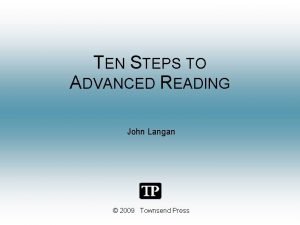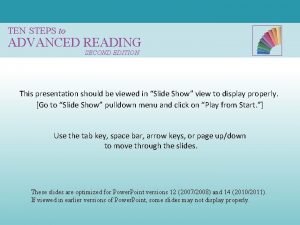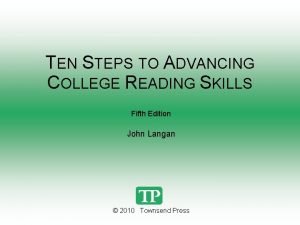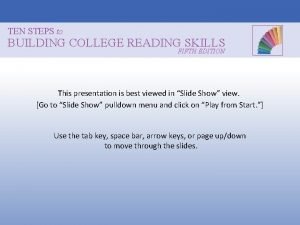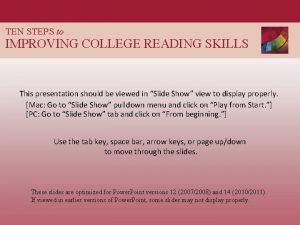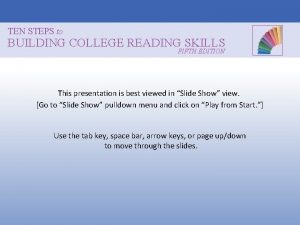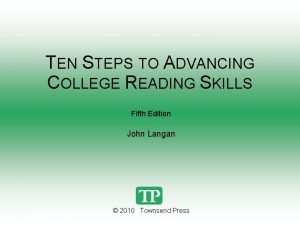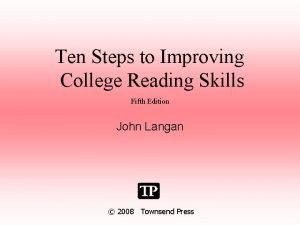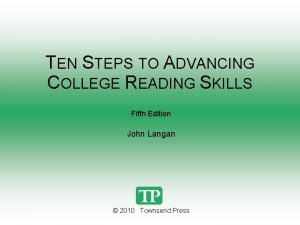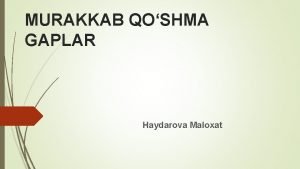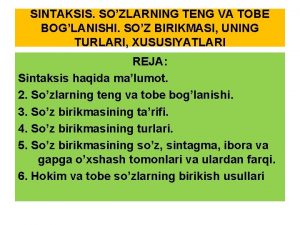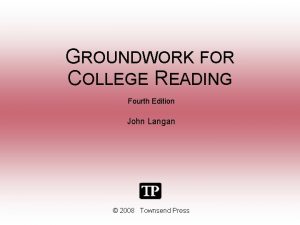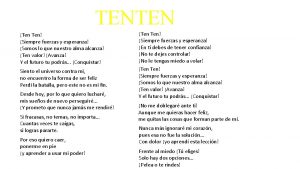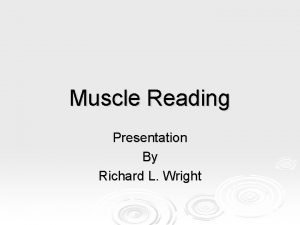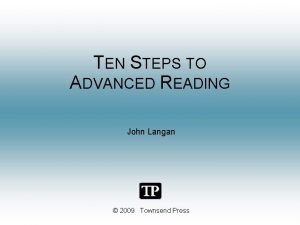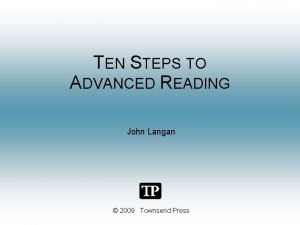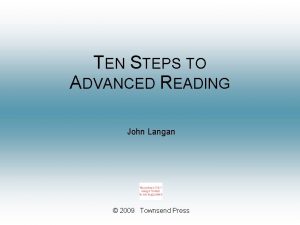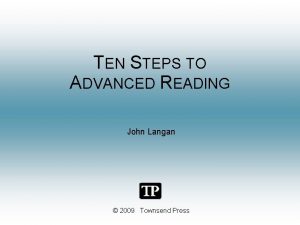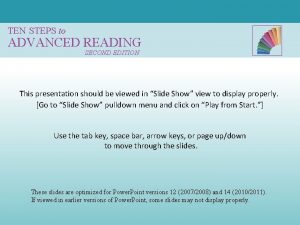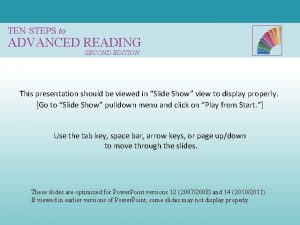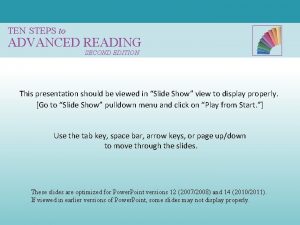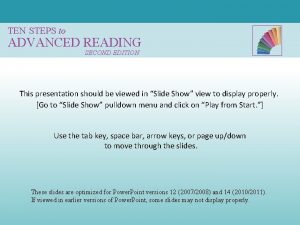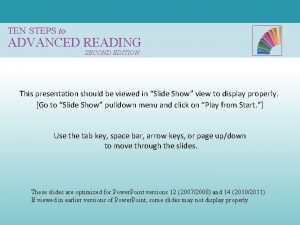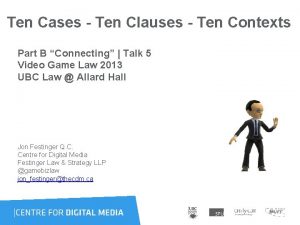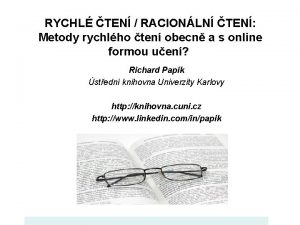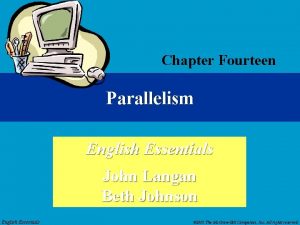TEN STEPS TO ADVANCED READING John Langan 2009


























- Slides: 26

TEN STEPS TO ADVANCED READING John Langan © 2009 Townsend Press

Chapter Seven: Purpose and Tone The purpose of this newspaper photo is to inform us of the return of American soldiers killed in Iraq. The tone of the photo is one of solemnity, reverence, and respect.

PURPOSE AND TONE Part of reading critically is being aware of an author’s purpose and tone. • Purpose — the author’s reason for writing • Tone — the expression of the author’s attitude and feeling about a subject

PURPOSE Three common purposes (reasons for writing) are • To inform — to give information about a subject. • To persuade — to convince the reader to agree with the author’s point of view on a subject. • To entertain — to amuse and delight; to appeal to the reader’s senses and imagination.

PURPOSE The cover and title of anything you read often suggest the author’s primary purpose. What do you think is the main purpose of each of these books? Primary purpose: A. to inform B. to persuade C. to entertain

PURPOSE The cover and title of anything you read often suggest the author’s primary purpose. What do you think is the main purpose of each of these books? Primary purpose: A. to inform B. to persuade C. to entertain

PURPOSE Read the paragraph below and decide what the author’s purpose is. The typical American gobbles three burgers and four orders of fries every week. Toss in the pizzas, the popcorn, the sugary breakfast cereals, the sodas, the snack cakes, candy bars, ice cream and everything else we eat in lieu of real food in this society, and your body is like an eighteen-wheeler roaring down a high-fat highway straight to obesity and an early grave. Fast food is bad food. It’s loaded with bad stuff like fat and sugar and sodium. It’s packed with chemicals that are in there to make it taste and smell and feel like it’s real food. What it lacks is vitamins, minerals, fiber, all the stuff you really need. Primary purpose: A. to inform B. to persuade C. to entertain

PURPOSE The typical American gobbles three burgers and four orders of fries every week. Toss in the pizzas, the popcorn, the sugary breakfast cereals, the sodas, the snack cakes, candy bars, ice cream and everything else we eat in lieu of real food in this society, and your body is like an eighteen-wheeler roaring down a high-fat highway straight to obesity and an early grave. Fast food is bad food. It’s loaded with bad stuff like fat and sugar and sodium. It’s packed with chemicals that are in there to make it taste and smell and feel like it’s real food. What it lacks is vitamins, minerals, fiber, all the stuff you really need. Primary purpose: A. to inform B. to persuade C. to entertain Explanation The author wants to persuade us that we should not indulge in fast food by describing how bad it is for us.

PURPOSE Read the paragraph below and decide what the author’s purpose is. I don’t know which is harder, taking my body to the doctor or my car to the garage. Both worry me. I’m always afraid they’ll find something I didn’t know about. The only advantage of taking my body to the doctor over taking my car to the garage is that the doctor never asks me to leave it overnight. Primary purpose: A. to inform B. to persuade C. to entertain

PURPOSE I don’t know which is harder, taking my body to the doctor or my car to the garage. Both worry me. I’m always afraid they’ll find something I didn’t know about. The only advantage of taking my body to the doctor over taking my car to the garage is that the doctor never asks me to leave it overnight. Primary purpose: A. to inform B. to persuade C. to entertain Explanation The author’s purpose is to entertain with playful and exaggerated details. (Clearly, the doctor is not going to ask the writer to leave his body overnight!)

PURPOSE Read the paragraph below and decide what the author’s purpose is. Personal contact is necessary for common cold viruses to spread. The viruses must get into the nose, where they can infect the nasal membranes. Inhaling contaminated droplets produced when someone else coughs or sneezes may be one way to catch a cold. Cold viruses can remain infective even if they are outside the body for a few hours. Therefore, you can also catch a cold if you handle something that is contaminated with a cold virus—for example, the doorknob of a classroom or a restroom door—and then scratch your nose or rub your eyes with your contaminated fingers. The cold viruses can reach your nose when you rub your eyes because the virus can be passed down the tear ducts that go from the eyes into the nasal cavities. Primary purpose: A. to inform B. to persuade C. to entertain

PURPOSE Personal contact is necessary for common cold viruses to spread. The viruses must get into the nose, where they can infect the nasal membranes. Inhaling contaminated droplets produced when someone else coughs or sneezes may be one way to catch a cold. Cold viruses can remain infective even if they are outside the body for a few hours. Therefore, you can also catch a cold if you handle something that is contaminated with a cold virus—for example, the doorknob of a classroom or a restroom door—and then scratch your nose or rub your eyes with your contaminated fingers. The cold viruses can reach your nose when you rub your eyes because the virus can be passed down the tear ducts that go from the eyes into the nasal cavities. Primary purpose: A. to inform B. to persuade C. to entertain Explanation The author’s purpose is to inform the reader about how cold viruses spread by presenting facts about the kinds of personal contact that can lead to infection.

PURPOSE • Sometimes a writer may blend two or even three purposes. • In such cases, focus on the author’s primary purpose. Ask yourself, “What is the author’s main idea? ”

TONE • A writer’s tone reveals the attitude he or she has toward a subject. • Tone is expressed through the words and details the writer selects.

TONE Below are three statements by students of a demanding teacher. Notice the differences in tone. She’s tough, but she’s also really good. I’ve learned more from her than I’ve learned from any other teacher. Tone: Fair, objective Yeah, I love her. Just like I love sleeping on a bed of nails or having bamboo slivers pushed under my fingernails. Tone: Sarcastic I might as well stop going to class now. I’m never going to understand the material. It’s hopeless. Tone: Pessimistic

TONE Here is another statement by a student of the demanding teacher. How would you describe the tone? She hates students, that’s all there is to it. I can’t wait until I’m out of her class.

TONE Here is another statement by a student of the demanding teacher. How would you describe the tone? She hates students, that’s all there is to it. I can’t wait until I’m out of her class. Tone: bitter, angry

TONE Pages 261 to 263 in your textbook list more than eighty words that describe tone.

TONE What is the tone of each of the following statements? Wal-Mart may create an economic underclass in our town. Its employees aren’t paid enough to live on, and they have very poor benefits. The tone is: A. optimistic B. worried C. threatening Wal-Mart is a fact of life. It’s going to hurt some people, but at least we’ll be able to buy a lot of things at lower prices. The tone is: A. indignant B. pleading C. accepting

TONE What is the tone of each of the following statements? Wal-Mart may create an economic underclass in our town. Its employees aren’t paid enough to live on, and they have very poor benefits. Explanation The tone is: A. optimistic B. worried C. threatening The writer’s concerns that Wal-Mart’s low wages and benefits may have a negative economic effect on the town suggests a worried tone. Wal-Mart is a fact of life. It’s going to hurt some people, but at least we’ll be able to buy a lot of things at lower prices. The tone is: Explanation A. indignant B. pleading C. accepting The writer’s statement that “Wal-Mart is a fact of life” indicates acceptance, as does her effort to balance the negative aspects with the benefit of lower prices.

TONE A Note on Irony and Sarcasm • One commonly used tone is irony. • Irony involves a contrast between expectations and reality.

TONE A Note on Irony and Sarcasm is a form of verbal irony. In the three examples below, notice the contrast between what is said and what is actually meant. Examples — A friend asks how you like your new boss. You reply, “He’s great. It’s refreshing to work for someone who has half my I. Q. ” — You break up with your girlfriend, who becomes hysterical and slaps you. You say to yourself afterward, “I think she took that well. ” — An instructor has an extremely cold, businesslike manner. You tell a classmate, “I really like the warmth and concern she shows her students. ”

TONE A Note on Irony and Sarcasm • Irony also refers to situations that involve a contrast between what is expected or intended and what actually happens. • In the two examples below, notice how what actually happens is contrary to what is expected or intended. Examples — While fastening his seat belt to keep himself safe, a man loses control of his car and crashes. — Ludwig van Beethoven, perhaps the greatest composer who ever lived, became totally deaf and could not hear his own music.

TONE A Note on Irony and Sarcasm Frank and Ernest © by Thaves. All rights reserved. What is the irony in the sign that a communication workshop will be “sometime tonight in a room upstairs”?

TONE A Note on Irony and Sarcasm Frank and Ernest © by Thaves. All rights reserved. What is the irony in the sign that a communication workshop will be “sometime tonight in a room upstairs”? Explanation The irony is that the sign advertising a communication workshop fails to communicate just when and where the workshop will be.

CHAPTER REVIEW In this chapter, you learned that part of reading critically is to do the following: • Be aware of an author’s purpose: the reason he or she writes. Three common purposes are to inform, to persuade, and to entertain. • Be aware of tone—the expression of the author’s attitude and feeling about the subject. A writer’s tone might be objective—the case in most textbook writing—or it might be lighthearted, sympathetic, angry, affectionate, respectful, or any of the other tones shown on pages 261– 263. One important tone to recognize is irony: saying one thing but meaning the opposite. The next chapter—Chapter 8—will explain another part of reading critically: recognizing an author’s point and evaluating the support for that point.
 Ten steps to advanced reading answer key
Ten steps to advanced reading answer key Ten steps to advanced reading
Ten steps to advanced reading Ten steps to advancing college reading skills answers
Ten steps to advancing college reading skills answers Ten steps to advancing college reading skills
Ten steps to advancing college reading skills Clear thinking and writing john langan
Clear thinking and writing john langan Ten steps to improving college reading skills
Ten steps to improving college reading skills Ten steps to building college reading skills answer key
Ten steps to building college reading skills answer key Ten steps to advancing college reading skills
Ten steps to advancing college reading skills Ten steps to advancing college reading skills
Ten steps to advancing college reading skills 10 steps to advancing college reading skills
10 steps to advancing college reading skills Qo'shma gaplar haqida ma'lumot
Qo'shma gaplar haqida ma'lumot So'z birikmasi sintaksisi haqida
So'z birikmasi sintaksisi haqida Langan pronunciation
Langan pronunciation While reading activities
While reading activities It's ten twenty
It's ten twenty Ten ten siempre fuerzas y esperanza
Ten ten siempre fuerzas y esperanza Ten ten program
Ten ten program Ten mile day
Ten mile day What is axial movements or non locomotor movements?
What is axial movements or non locomotor movements? Muscle reading
Muscle reading John dewey problem solving steps
John dewey problem solving steps Round robin reading vs popcorn reading
Round robin reading vs popcorn reading Aims of teaching reading
Aims of teaching reading 2 types of reading
2 types of reading What is shared reading
What is shared reading Why is critical reading an active process of discovery
Why is critical reading an active process of discovery Intensive reading and extensive reading
Intensive reading and extensive reading
